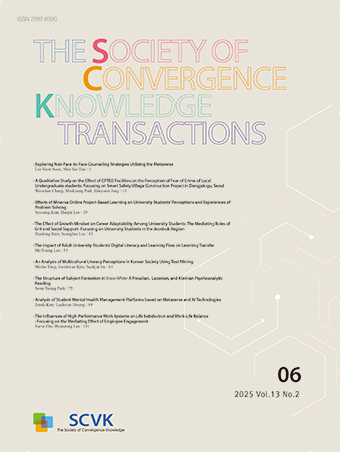Research Article
Abstract
References
Information
세계적으로 화석연료 사용에 의한 CO2 배출량 증가로 인한 기후변화로 인하여 신재생에너지에 대한 관심이 높아지고 있다. 이에 여러 분야의 신재생에너지 기술이 발달하고, 그에 대한 연구가 진행되고 있으며, 열음향 시스템에 대한 기술적 연구는 꾸준히 진행중이다. 열음향 시스템은 엔진, 펌프, 냉장 및 냉동기, 레이저 등 다양한 분야에 이용이 가능하며, 압축기와 같은 기계를 필요로 하지 않기 때문에 비교적 구조가 간단하기 때문에 에너지 손실을 줄일 수 있다. 열음향파 발생장치를 구성하여 공진기의 직경과 길이는 고정한 상태에서 스택의 길이와 공급 전압을 변화시킨 후 발생하는 주파수와 dB, 온도를 측정하였으며 이에 변화를 확인하였다. 실험 결과 스택의 길이와 공급하는 전압의 변화는 발생하는 열음향파의 주파수 변화에는 영향이 없는 것으로 확인하였으며, 공급하는 전압이 커질수록 dB로 증가하는 것을 확인하였다. 또한 스택의 길이에 따라서 발생하는 온도차이에 의하여 스택의 길이가 길어질수록 열음향파의 발생시간이 증가함을 확인할 수 있었다. 이와 같은 실험결과를 활용하여 열음향파의 기초 데이터 자료로 활용이 가능할 것으로 사료된다.
Global interest in renewable energy is increasing due to climate change caused by increased CO2 emissions from fossil fuel use. As a result, renewable energy technology in various fields is developing, research is underway on it, and technical research on thermal acoustic systems is steadily underway. Thermoacoustic systems are available in various fields such as engines, pumps, refrigerators and refrigerators, and lasers, and do not require machines such as compressors, which can reduce energy loss because of its relatively simple structure. In this work, we conduct experiments on the length of the stack of thermoacoustic waves and the effect of the voltage supplied on the frequency, dB, and temperature differences before and after the stack. A thermosound wave generating device was constructed to measure the frequency, dB, and temperature generated by varying the length and supply voltage of the stack while the diameter and length of the resonator were fixed. Experiments show that changes in the length of the stack and the voltage supplied have no effect on the frequency changes of the thermosound wave, and that the voltage supplied increases to dB as the voltage supplied increases. It was also confirmed that the longer the stack is, the longer the length of the stack, the more time the thermal acoustic wave occurs. Using these experimental results, it is believed that it can be used as basic data for thermal acoustic waves.
- 진상현, 한준, "신 ‧ 재생에너지의 개념 및 정책적 타당성에 관한 연구", 한국정책학회보, 제18권 제1호, pp.187-208, 2009.
- 김원섭, 김종만, "신재생에너지 대전력 마이크로파 발생 장치 개발과 연구", 한국에너지학회 추계학술발표회, pp.192-192, 2020.
- 오승진, 이윤준, 신상웅, 임상훈, 천원기, "열음향(Thermoacoustic) 레이저의 음향파 특성 분석", 한국태양에너지학회 논문집, 제31권 제6호, pp.1-7, 2011.https://doi.org/10.7836/kses.2011.31.6.001
- 황인주, "압축성 유체의 급속가열에 기인한 열음향파의 생성과 열전달", 박사학위 졸업논문.
- 김남진, "열음향 레이저의 공명튜브와 스택 변화에 따른 음파특성", 기계저널, 제58권 제12호, pp.47-51, 2018.
- 신상웅, 오승진, 이윤준, 김남진, 천원기, "열음향파 발생장치의 최적 작동 조건에 대한 실험적 연구", 대한기계학회논문집 B권, 제37권 제2호, pp.131-137, 2013.https://doi.org/10.3795/KSME-B.2013.37.2.131
- M. E. H. Tijani, and S. Spoelstra, "A High Performance Thermoacoustic Engine", Journal of Applied Physics, Vol. 110, No. 9, 093519, 2011.https://doi.org/10.1063/1.3658872
- 박성식, 천원기, 김남진, "스택의 채널 수에 따른 열음향파의 특성 비교 연구", 한국태양에너지학회 논문집, 제33권 제4호, pp.8-14, 2013.https://doi.org/10.7836/kses.2013.33.4.008
- 이남길, 신완순, 우삼용, 박종호, "열음향 냉동효과에 관한 연구", 대한기계학회 춘추학술대회, pp.85-90, 1997.
- 김동혁, "공명관식 열음향 냉동기의 최적설계를 위한 수치모사 및 설계인자 분석", 설비공학논문집, 제7권 제2호, pp.329-340, 1995.
- 오상훈, "밀폐관형 스피커구동 열음향 냉동기의 주파수 및 온도변화 연구", 한국해양대학교 공학석사 학위논문, 2003.
- 김이삭, 이종주, "소리에너지를 이용한 소형냉동기 모델에 대한 연구", 전국과학전람회.
- C. M. Donaghy-Spargo, "On Heaviside's Contributions to Transmission Line Theory: Waves, Diffusion and Energy Flux", Philosophical Transactions of the Royal Society A: Mathematical, Physical and Engineering Sciences, Vol. 376, No. 2134, 2018.https://doi.org/10.1098/rsta.2017.0457PMid:30373946
- A. T. A. M. de Waele, "Basic Operation of Cryocoolers and Related Thermal Machines", Journal of Low Temperature Physics, Vol. 164, No. 5-6, pp. 179-236, 2011.https://doi.org/10.1007/s10909-011-0373-x
- G. Swift, and S. L. Garrett, "Thermoacoustics: A Unifying Perspective for Some Engines and Refrigerators", The Journal of the Acoustical Society of America, Vol. 113, No. 5, 2003.https://doi.org/10.1121/1.1561492
- 서성현, 강상훈, 배종열, 이진영, "열음향 공진 점화에 대한 연구", 한국추진공학회지, 제20권 제1호, pp.82-89, 2016.https://doi.org/10.6108/KSPE.2016.20.1.082
- H. S. Sprenger, "Uber Termische Effecte bei Rezonanzrohren", Mitteilungs aus dem Institut fur Aerodynamik, No. 21, pp. 18-35, 1954.
- 신상웅, 오승진, 이윤준, 김남진, 천원기, "열음향(Thermoacoustic) 레이저의 음향주파수 특성 분석", 한국태양에너지학회 추계학술발표대회 논문집, pp.331-336, 2012.
- 오승진, 오원종, 이윤준, Kuan Chen, 천원기, "태양열 적용 열음향레이져 설계 및 제작, 한국에너지학회 춘계학술발표회, pp.246-246, 2010.
- I. Paek, "Performance Characterization of Thermoacoustic Cooler Components and Systems", Doctor of Philosophy, 2005.
- 박성식, 오승진, 천원기, 김남진, "태양에너지 이용을 위한 열음향파의 음압 특성 비교 연구", 한국태양에너지학회 추계학술발표대회 논문집, pp.325-330, 2012.
- T. Ohara, "Molecular-Scale View of Heat Conduction in Liquides, Soft Matters, and Their Interfaces", 대한기계학회 열공학부문 춘계학술대회 논문집, pp.3-6, 2019.
- Publisher :The Society of Convergence Knowledge
- Publisher(Ko) :융복합지식학회
- Journal Title :The Society of Convergence Knowledge Transactions
- Journal Title(Ko) :융복합지식학회논문지
- Volume : 9
- No :3
- Pages :27-35
- DOI :https://doi.org/10.22716/sckt.2021.9.3.026




 The Society of Convergence Knowledge Transactions
The Society of Convergence Knowledge Transactions







